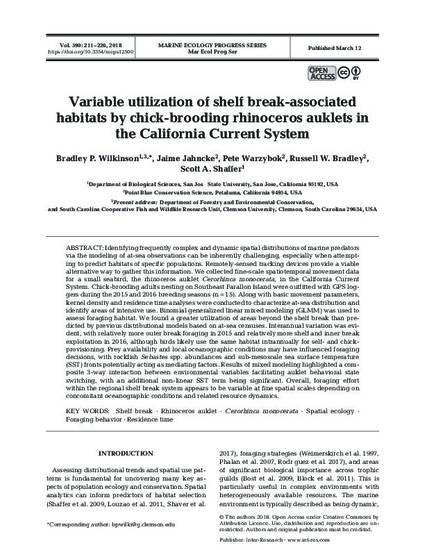
Article
Variable utilization of shelf break-associated habitats by chick-brooding rhinoceros auklets in the California Current System
Marine Ecology Progress Series
(2018)
Abstract
Identifying frequently complex and dynamic spatial distributions of marine predators via the modeling of at-sea observations can be inherently challenging, especially when attempting to predict habitats of specific populations. Remotely-sensed tracking devices provide a viable alternative way to gather this information. We collected fine-scale spatiotemporal movement data for a small seabird, the rhinoceros auklet Cerorhinca monocerata, in the California Current System. Chick-brooding adults nesting on Southeast Farallon Island were outfitted with GPS loggers during the 2015 and 2016 breeding seasons (n = 15). Along with basic movement parameters, kernel density and residence time analyses were conducted to characterize at-sea distribution and identify areas of intensive use. Binomial generalized linear mixed modeling (GLMM) was used to assess foraging habitat. We found a greater utilization of areas beyond the shelf break than predicted by previous distributional models based on at-sea censuses. Interannual variation was evident, with relatively more outer break foraging in 2015 and relatively more shelf and inner break exploitation in 2016, although birds likely use the same habitat intrannually for self- and chick-provisioning. Prey availability and local oceanographic conditions may have influenced foraging decisions, with rockfish Sebastes spp. abundances and sub-mesoscale sea surface temperature (SST) fronts potentially acting as mediating factors. Results of mixed modeling highlighted a composite 3-way interaction between environmental variables facilitating auklet behavioral state switching, with an additional non-linear SST term being significant. Overall, foraging effort within the regional shelf break system appears to be variable at fine spatial scales depending on concomitant oceanographic conditions and related resource dynamics.
Keywords
- Shelf break,
- Rhinoceros auklet,
- Cerorhinca monocerata,
- Spatial ecology,
- Foraging behavior,
- Residence time
Disciplines
Publication Date
March 12, 2018
DOI
10.3354/meps12500
Publisher Statement
This article was originally published in Marine Ecology Progress Series Vol. 590 by Inter-Research on March 12, 2018, DOI: 10.3354/meps12500. The article is also available online at this link.
Citation Information
Bradley P. Wilkinson, Jaime Jahncke, Pete Warzybok, Russell Bradley, et al.. "Variable utilization of shelf break-associated habitats by chick-brooding rhinoceros auklets in the California Current System" Marine Ecology Progress Series Vol. 590 (2018) p. 211 - 226 ISSN: 0171-8630 Available at: http://works.bepress.com/scott_shaffer/59/
Creative Commons license

This work is licensed under a Creative Commons CC_BY International License.
